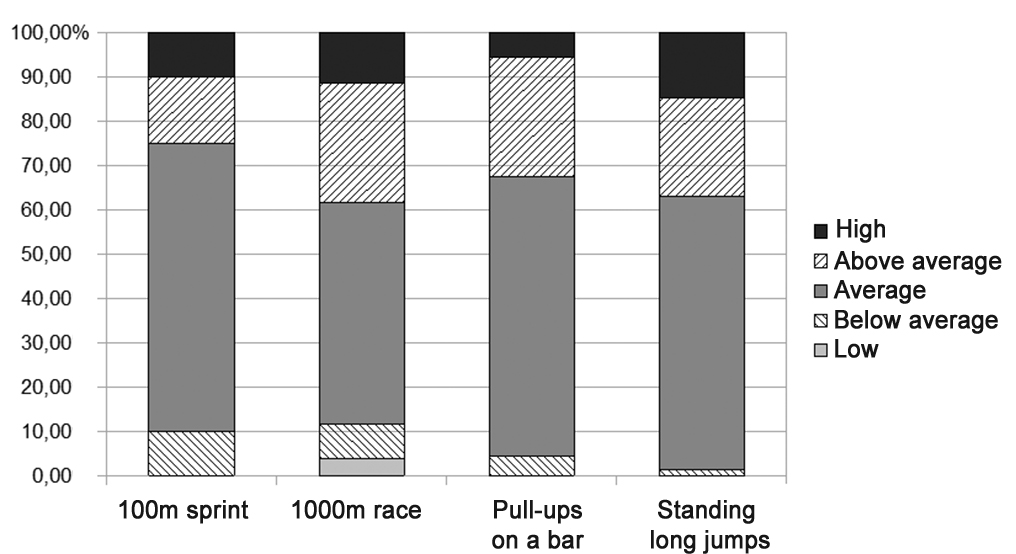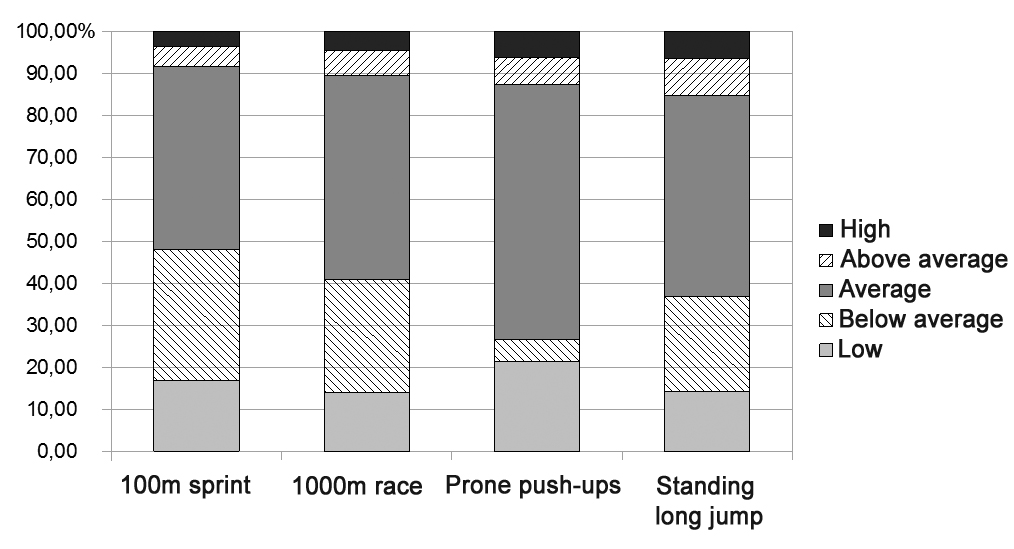Encouraging students' self-training for success in GTO complex tests
Фотографии:
ˑ:
PhD, Professor V.E. Mogilev1
PhD, Associate Professor L.V. Byankina1
Dr.Hab., Professor I.M. Vorotilkina2
1Far Eastern State Academy of Physical Culture, Khabarovsk
2Sholom Aleichem Amur State University, Birobidzhan
Keywords: self-training practices, physical fitness rates, Russian Physical Culture and Sports “Ready for Labour and Defence” (GTO) Complex.
Background. Health is increasingly ranked today among the top values and priorities both by the governmental policy makers and many individuals. An individual physical status may be described as an integrated characteristic of the individual physical development and physical fitness levels; and it has always been a subject of research and analyses with a special emphasis on a variety of factors of influence on this status. It is a matter of common knowledge that a public physical health status largely depends on climatic, geographic and socioeconomic conditions. In this context, due efforts need to be taken to develop new and update the existing regional standards – that are critically necessary for the regional physical culture systems [2].
Individual physical statuses are also directly dependent on physical training systems – both their institutional (academic education) and self-reliant formats. It is the Russian Physical Culture and Sports “Ready for Labour and Defence” (GTO) Complex that is currently ranked among the most promising ways to improve the popular physical training and fitness standards in the Russian Federation; as it offers a set of age-specific physical fitness rating standards with the qualifiers awarded with Gold, Silver and Bronze GTO Badges [3]. The GTO Complex tests have been reinstated as an effective motivator for physical progress of trainees and their qualifications for the test badges, and presently their implementation matters and benefits are subject to many theoretical and practical studies.
Objective of the study was to obtain experimental data demonstrating benefits of an academic self-reliant physical training system for the GTO Complex tests.
Methods and structure of the study. The study was designed to include the following stages. Stage one implied mass primary tests to rate students’ pre-experimental physical fitness. At stage two, we piloted a self-reliant physical activity encouraging system at a specific university and profiled the academic physical progress throughout the education period. At stage three, we analysed the post-experimental data versus the valid GTO Complex test Class VI standards. Subject to the study were 890 students (532 men and 358 women) of the Russian Far Eastern Khabarovsk and Birobidzhan Universities. Their physical fitness was rated by the following classical tests selected for comparative purposes: 100 m sprint; 1000 m race; standing long jump; prone push-ups for women; and pull-ups on a horizontal bar for men. It should be noted that the 1000 m race test is beyond the standard set of the GTO Complex test in fact, but we considered and applied it as highly informative for the endurance rating purposes.
Study results and discussion. The valid Sample Curricula of the academic Physical Education discipline (as of 2000) provides a set of physical fitness tests to rate the academic physical progress of the basic and sporting department students [4]. It should be mentioned that presently many universities approve and apply their own progress rating scales and lists of academic physical progress rating tests. Practical results of the physical progress tests under the study were classified versus the rating levels provided by the valid Sample Curricula of the academic Physical Education discipline. Our analysis of the practical test data versus the valid standards of the Sample Curricula showed that the latter are somewhat understated. In our analyses of the practical test data, we applied a grading system including the “low”, “average” and “high” grades plus the interim “above the average” and “under the average” grades rather than rating points (see Figure 1,2); with the “high” and “low” rates corresponding to traditional 5 and 1 points, respectively.
Having analysed the speed development rates, the trainees’ fitness in this component was proved to be “high” (qualifying for the Gold GTO Badge) in 10% of the tested men and 3% of the tested women; and “above the average (qualifying for the Silver GTO Badge) in 13% of the tested men and 4% of the tested women.

Figure 1. Men’s classified physical fitness test rates

Figure 2. Women’s classified physical fitness test rates
Most of the subjects (65% of men and 42% of women) were tested with average physical fitness rates qualifying for the Bronze GTO Badge. The academic endurance progress tests showed much the same variations as for the speed tests i.e. the women showed a lower progress versus men as verified by the higher proportion of the “below the average” and “low” test rates in the women’s group.
The strength tests (pull-ups on a horizontal bar for men and prone push-ups for women) yielded the following rates: 5% “high” for both men and women; 28% and 7.5% “above the average” for men and women, respectively; and 63% and 60% “average” for men and women, respectively. In the standing long jump test, men showed a better progress, with no one rated “low” and only 1.4% rated “below the average”. In the women’s sample, 5% were rated “high”; 10% “above the average”; and 45% “average” in this test. The test rates were good enough for 6-15% of the men and 3-5% of the women to qualify for the Gold GTO Badge, with much more subjects tested fit for the Silver and Bronze GTO Badges.
Furthermore, an elective academic Healthy Lifestyle and Literature discipline was designed to develop due motivations for healthy lifestyles and encourage self-reliant and active physical development in students [1]. The discipline was designed as follows: lectures to deliver general theoretical basics of healthy lifestyle; cultivate the moral and ethical motivations for the healthy lifestyles; encourage due physical training and sporting activity by means of relevant literature; and offer workshops to analyse the relevant literary works from the viewpoint of the health protection and promotion values.
Furthermore, the Theoretical and Practical Basics of Healthy Lifestyles course was offered making a special emphasis on a few key issues including the role of physical culture in the health protection domain; academic living standards and their health implications; values-driven agendas of students; fundamentals of self-training process; self-training systems: forms and content; hygienic requirements to self-training systems; physical self-development and self-improvement as the basics of healthy lifestyle; self-control tools to ensure an efficient self-training system; physical education methods applied to control mental, emotional and physical condition during examination sessions; and “minor” physical training forms in the academic education process.
The proposed system was proved efficient as verified by the students’ physical fitness tests prior to and after the experimental course to rate their progress versus the relevant standards. The Study and Reference Group post-experimental test rates showed the following significant differences in the following strength quality tests: 7% progress rate in the standing long jump test; 9.4% progress rate in the men’s pull-ups on a horizontal bar; and 13% progress rate in the women’s prone push-ups test. The sprint and race tests did not show any significant differences in the pre- and post-experimental test rates; however, our monitoring of the further physical progress of the trainees in the post-experimental period showed an accumulative effect and further progress trend with the gap between the average tests rates of the Study Group versus Reference Group found to stay later on.
Conclusion. The study data and analyses showed the subjects’ physical progress in getting fit for the GTO Complex tests to be gender-specific. The share of the students tested fit for the Gold GTO Badge varied within the range of 3% to 15% in the sample regardless of the gender; and 4-27% of men and 3-10% of women were tested fit for the Silver GTO Badge. Most of the tested students (63% of men and 45% of women) were tested fit for the Bronze GTO Badge. Analyses of the gender-specific test rates generated by different tests showed the sprint and race tests to be the most challenging for the Far Eastern academic population versus their good progress in the speed- and speed-strength tests where most of the students could qualify for the GTO Complex Badges. It is important that these physical qualities are also well developed by self-training.
References
- Vorotilkina I.M. Razvitie samostoyatelnosti detey i uchashcheysya molodezhi v dvigatelnoy deyatelnosti [Development of self-training habits in children and students]. Psikhologiya obucheniya, 2011, no. 8, pp. 105-113.
- Mogilev V.E., Chekulaev N.N., Byankina L.V. Kompleksnaya otsenka fizicheskogo razvitiya i fizicheskoy podgotovlennosti shkolnikov otdelnykh regionov Dalnego Vostoka Rossii: metod. rekom. [Comprehensive assessment of physical development and physical fitness of schoolchildren in selected regions of the Russian Far East. Guidance]. Khabarovsk: FESAPC publ., 2013, 36 p.
- Normy GTO.ru: sayt. [GTO.ru morms: website.]. Available at: http://www.gto-normy.ru (06.02.2017).
- Ilyinich V.I., Evseev Y.I. Fizicheskaya kultura. Primernaya programma distsipliny federalnogo komponenta [Physical Education. Sample program of discipline of federal component]. Moscow, 2000, 35 p.
Corresponding author larisa.byankina@gmail.com
Abstract
Health-centred physical culture building is one of the key purposes of any education institution attainable mostly by traditional physical culture methods dominated by the common body conditioning tools. The study considers classified physical fitness tools in application to students of the Khabarovsk and Birobidzhan Universities and their progress in the physical fitness system designed with a special emphasis on self-reliant body conditioning practices. We used the study data and analysis to rate the students’ physical progress versus the valid Russian Physical Culture and Sports “Ready for Labour and Defence” (GTO) Complex test standards in the academic education process. The study data and analyses showed that the share of students fit for the GTO Gold Badge qualification tests is small enough varying from 3-15% in the both gender groups. The students’ fitness for the GTO Silver Badge qualification tests was found somewhat higher (4-27% for men and 3-10% for women). And the students’ fitness for the GTO Bronze Badge qualification tests was estimated at 63% for men and 45% for women. Having analysed the gender-specific physical fitness rates versus the valid GTO test standards, the sprint and race tests were found to be the most challenging for the Far Eastern young people; whilst the strength- and speed-strength GTO Badge qualification tests were surmountable for most of the students for the reason that the relevant abilities are well developed by self-training.




